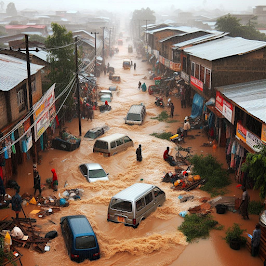Climate change is no longer a distant concern—it is a pressing issue that has a profound impact on water resources across the globe, with Africa and Kenya being among the most affected regions. Erratic weather patterns, prolonged droughts, and diminishing water sources are reshaping livelihoods and ecosystems, threatening the very foundation of sustainable development. This blog delves into how climate change is affecting water resources in Africa, particularly Kenya, and explores actionable solutions to mitigate these challenges.
The Impact of Climate Change on Water Resources in Africa and Kenya
-
Prolonged Droughts and Reduced Rainfall
Climate change has intensified the frequency and severity of droughts in Africa, with Kenya experiencing some of its worst droughts in recent history. Regions like the ASAL (Arid and Semi-Arid Lands) are particularly vulnerable, as reduced rainfall leads to drying rivers and groundwater depletion. This severely affects agriculture, which depends heavily on rain-fed irrigation. -
Increased Water Scarcity
According to the World Resources Institute, sub-Saharan Africa is home to 17 of the world's most water-stressed countries. In Kenya, urban areas like Nairobi and Mombasa often face water rationing due to inadequate supply and overstressed infrastructure, while rural communities walk long distances to access shrinking water sources.
-
Flooding and Contaminated Water Sources
Erratic weather patterns have increased the likelihood of flash floods, contaminating rivers and boreholes with debris and pollutants. In Kenya, the River Tana frequently experiences contamination during flooding, rendering it unsafe for consumption and irrigation. This exacerbates waterborne diseases, including cholera and dysentery.
-
Loss of Wetlands and Ecosystems
Kenya’s vital ecosystems, like the Mau Forest and Lake Victoria basin, are under pressure from deforestation and climate-induced stress. Wetlands, which act as natural water reservoirs, are shrinking, impacting biodiversity and reducing natural water filtration systems. -
Declining Hydropower Generation
Kenya relies heavily on hydropower for electricity. However, reduced water levels in reservoirs and rivers have caused inconsistent energy supply, affecting industries and households. For example, water shortages in the Turkwel and Masinga dams have forced Kenya Power to seek alternative energy sources.
What We Can Do to Mitigate the Impact of Climate Change on Water Resources
-
Promote Water Conservation Practices
- Encourage the use of rainwater harvesting systems in homes, schools, and farms.
- Educate communities on reducing water wastage, such as fixing leaks and using water-efficient appliances.
-
Invest in Sustainable Water Management
- Governments and NGOs should invest in resilient infrastructure, such as dam rehabilitation and smart irrigation systems.
- Adopt technologies for groundwater mapping and monitoring to optimize water extraction.
-
Restore and Protect Ecosystems
- Reforestation and afforestation efforts, like the Mau Forest rehabilitation project, can help restore critical water catchment areas.
- Strengthen policies to protect wetlands and regulate deforestation activities.
-
Enhance Community Education and Engagement
- Conduct workshops to teach sustainable farming and water management techniques.
- Engage local communities in water resource decision-making to ensure practical and culturally relevant solutions.
-
Adopt Renewable Energy Solutions
- Reduce reliance on hydropower by diversifying into solar and wind energy.
- Encourage the use of solar-powered water pumps in rural and drought-prone areas.
-
Strengthen Regional Cooperation
- Collaborate on cross-border water resources like Lake Victoria to ensure fair and sustainable usage.
- Work with neighboring countries to address shared water challenges and build climate resilience.
-
Support Research and Innovation
- Fund research into climate-smart agriculture and water-efficient crop varieties.
- Encourage innovations in wastewater recycling and desalination to increase water availability.
Conclusion: Building a Resilient Future
The impacts of climate change on water resources in Africa and Kenya are undeniable, but with the right strategies, we can mitigate these effects and secure a sustainable future. Water conservation, investment in resilient infrastructure, and ecosystem restoration are just a few of the steps we must take. By acting collectively—governments, communities, and individuals—we can ensure that Africa and Kenya are better equipped to handle the challenges posed by climate change.
Together, we can safeguard our water resources and build a resilient future for generations to come.
This blog is SEO-optimized with keywords like climate change in Kenya, water resources in Africa, water conservation in Kenya, and sustainable water management, ensuring better visibility and engagement.












0 Comments